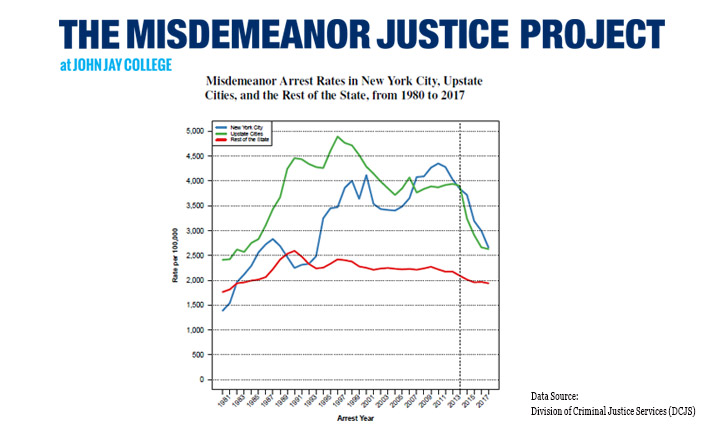
New Study on New York City & State Also Shows Racial Differences in Arrest Rates Persist
(New York, NY) – Misdemeanor arrests across New York State, particularly New York City and upstate cities continued to plummet over the past four years, but the differences in arrest rates between Whites and non-Whites held steady and in some cases, widened; this according to the new report, Trends in Misdemeanor Arrests in New York, 1980 to 2017, from the Misdemeanor Justice Project (MJP) at John Jay College of Criminal Justice. (View the Executive Summary)
“This report builds on MJP's efforts for the last six years to highlight changes in lower-level and misdemeanor enforcement that had received little attention previously but can have a significant impact on issues of public safety, police-community relations and the legitimacy of the criminal justice system,” said Associate Professor Preeti Chauhan, Director of MJP. “With this study, MJP provides an unbiased, empirical foundation for the important conversations across the State, and Country, about how best to produce public safety in a manner that is just and equitable.”
“New York has engaged in significant criminal justice reform and this recent report demonstrates that progress is starting to be made, but there is still work to be done. Nonetheless, I’m encouraged by the reduced enforcement of minor crimes, reduction in incarceration, and lower crime rates. John Jay College and the Misdemeanor Justice Project are perfectly positioned to research, document, and analyze these trends while illustrating how lower-level enforcement impacts communities,” said Karol V. Mason, President of John Jay College of Criminal Justice.
“This latest report from the Misdemeanor Justice Project shows New York has entered a new era of police-community relations. The statewide decline in misdemeanor arrests, combined with New York City’s historic drop in pedestrian stops and summonses, shows that law enforcement can safely de-prioritize arrests without an associated rise in crime rates. The Laura and John Arnold Foundation is proud to support the Misdemeanor Justice Project’s critical work tracking these enforcement trends,” said Jeremy Travis, Executive Vice President of Criminal Justice for the Laura and John Arnold Foundation.
The report, which adds the last four years of data to a previous report by MJP, traces misdemeanor arrests in three groups; New York City, Upstate Cities (Albany, Buffalo, Rochester, Syracuse and Yonkers), and the Rest of the State. It’s a continuation of MJP's efforts since its creation in 2013 to shine a light on the significant role that lower-level and misdemeanor enforcement play in just and equitable public policy.
Misdemeanor arrest rates peaked in New York City in 2010 (4,351 arrest per 100,000 people), and Upstate Cities in 1996 (4,892 per 100,000), before declining with both areas having a 2017 rate of about 2,650 per 100,000.
Rates of arrests for minorities went up and down during this time period as well, however, the numbers were consistently higher for non-Hispanic Blacks and Hispanics than Whites. For example, in New York City, the arrest rate for non-Hispanic Blacks rose from 4,539 per 100,000 in 1990 to a peak of 9,517 in 2010, before dropping to 5,571 per 100,000 in 2017.
In 2017, non-Hispanic Blacks were 5.2 times more likely than non-Hispanic Whites to be arrested for a misdemeanor in New York City, 3.1 times more likely to be arrested for a misdemeanor in Upstate Cities and 4.1 times more likely to be arrested for a misdemeanor in the Rest of the State.
Arrest rates for Hispanics in 2017 were lower relative to non-Hispanic Blacks but Hispanics were still 3.0 times more likely than non-Hispanic Whites to be arrested for a misdemeanor in New York City, 1.5 times more likely to be arrested for a misdemeanor in Upstate Cities and 1.6 times more likely to be arrested for a misdemeanor in the Rest of the State.
The types of charges driving misdemeanor arrests have also changed greatly over time with person-related charges like simple assault now accounting for the largest proportion of arrests compared to all other charge categories including property/theft, vehicle/driving, marijuana, drugs other than marijuana, and others.
For New York City, the proportion of person-related charges jumped from 11.4% in 1980 to 28.1% in 2017. Upstate Cities saw a rise from 18.5% to 31.0% and the Rest of the State saw an increase from 13.6% to 21.8%.
“Now, with this data in hand, we are collaborating with seven other jurisdictions across the United States, all part of MJP's Research Network on Misdemeanor Justice,” said Meredith Patten, the Executive Director of the Research Network. “We hope to further fill the gaps in our understanding of lower-level enforcement trends and assess whether recent reductions in enforcement levels are unique to New York or may be part of a larger nationwide or, even urban, phenomenon.”
View the full report, Trends in Misdemeanor Arrests in New York, 1980 to 2017.
About Misdemeanor Justice Project
The Misdemeanor Justice Project (MJP) is a research initiative at John Jay College of Criminal Justice dedicated to promoting a better understanding of the criminal justice system’s responses to the enforcement of lower level offenses. To date we have published reports on misdemeanor arrests, criminal summonses, pedestrian stops, mobility of arrests for misdemeanors, trends in jail admissions and custody, as well as conducted city-level evaluation work. For more information about the Misdemeanor Justice Project, please go to: www.misdemeanorjustice.org.
About John Jay College of Criminal Justice:
An international leader in educating for justice, John Jay College of Criminal Justice of the City University of New York is a Hispanic Serving Institution and Minority Serving Institution offering a rich liberal arts and professional studies curriculum to 15,000 undergraduate and graduate students from more than 135 nations. John Jay is home to faculty and research centers at the forefront of advancing criminal and social justice reform. In teaching, scholarship and research, the College engages the theme of justice and explores fundamental human desires for fairness, equality and the rule of law. For more information, visit www.jjay.cuny.edu and follow us on Twitter @JohnJayCollege.



